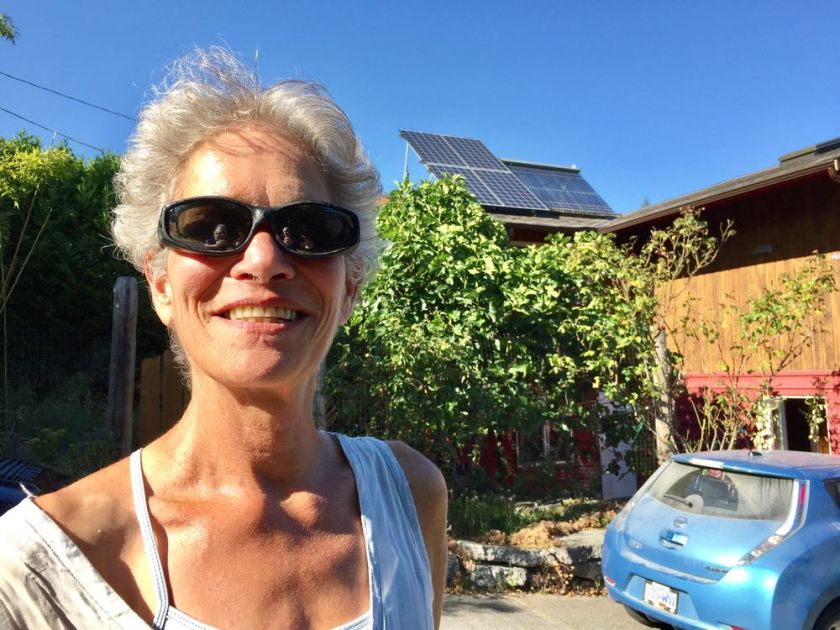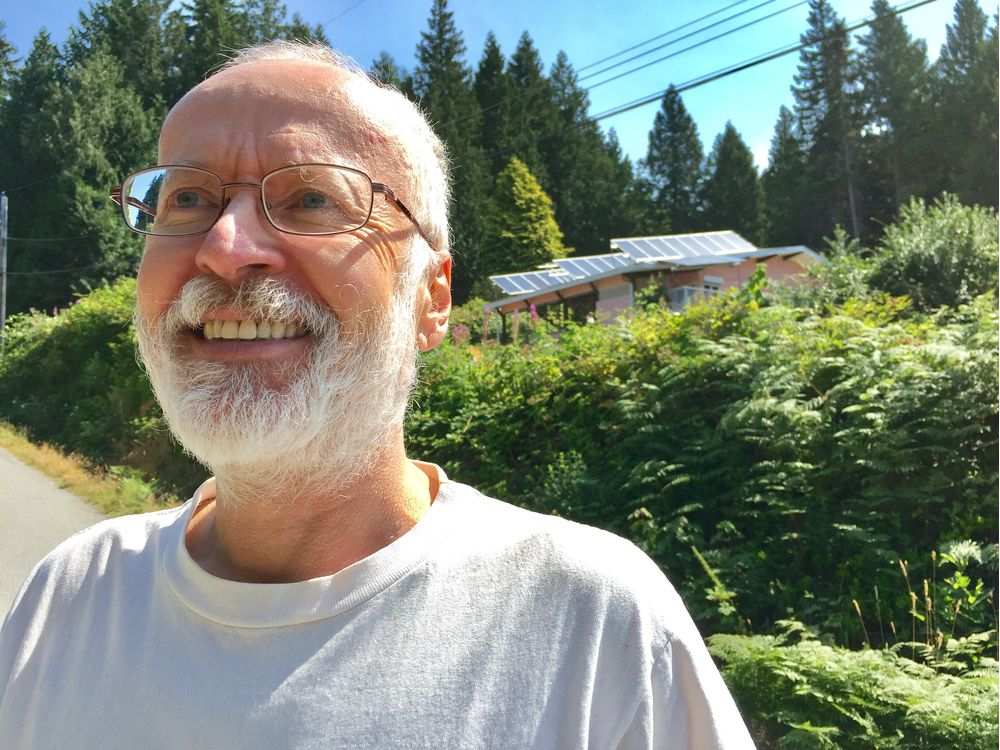RANDY SHORE Updated: July 21, 2017
Joanna Zilsel has solar panels on her roof and an electric car in her driveway. RANDY SHORE / PNG
If your solar dream is to go off the grid and cock a snook at B.C. Hydro in the process, dream on.
For all solar electricity’s advantages, in an environment where electricity is cheap and solar productivity is limited when you need it most, tapping into the sun’s power remains relatively expensive. And you are going to have to accept that you need B.C. Hydro’s help.
“B.C. Hydro is the big battery you need to get through the winter and that’s unavoidable. We live in Canada and it gets cold,” said Scott Elston, of Alternative Power Systems.
That’s not to say that solar photovoltaic electricity is a bad idea, but it takes both cash and commitment to achieve net-zero hydro consumption. And you have to be the kind of person who is willing to prepay for 10 to 25 years of electricity.
Gerry Pageau is just that sort of person, an engineer and longtime solar hobbyist who tracks the performance of each of his 31 solar panels individually.
“I’m a do-it-yourself kind of person,” he said. “I look at it like a Canada Savings Bond, except that solar power is inflation proof.”
While Pageau has done much of his own installation work with cleverly recycled mounting brackets over the course of several years, a professionally installed version of his 7.75 kilowatt rig would cost at least $23,000.
“As soon as you have to pay someone to install hardware for you then payback becomes poor to non-existent, as installed costs can easily reach $3 per watt,” he said.
During the summer, when the panels are at their most productive and his heating requirements are essentially zero, he powers two homes and sells the excess back to B.C. Hydro.
The other eight months of the year he sips from the grid and reckons annual savings on electricity of $1,200.
“I generate about 1,200 kilowatt hours a year for each kilowatt of installed panels,” said Pageau, a technical adviser for the Sunshine Coast Community Solar Association.
Doing the math, that means a rooftop array of 20 photovoltaic panels with a capacity of five kilowatts will cost around $15,000 installed and could save you up to $750 per year at B.C. Hydro’s highest Step 2 rate of 12.9 cents per kilowatt hour. Solar owners contacted by Postmedia News reported similar savings.
With a solar system grid tied to B.C. Hydro, you are even credited for excess power that flows back into the grid.
Best case scenario, you will pay off that investment in 20 years.
Gerry Pageau is the technical adviser for the Sunshine Coast Community Solar Association. Randy Shore, PNG RANDY SHORE / PNG
Oh, and when B.C. Hydro’s power goes down — as it frequently does in the winter — your grid-tied solar system goes down as well. Pageau has a separate set of photovoltaic panels with a battery to keep the fridge and freezer running during outages.
A photovoltaic system big enough to power a home through a cloudy December without drawing power from the grid would be many times bigger and commensurately expensive than a typical residential system. In practice, no one bothers trying.
“The point is to offset your winter consumption by overproducing power in the summer and keeping your winter consumption in the (cheaper) Step 1 rate for longer,” said Elston. “With the bigger systems, our customers aren’t buying any power from Hydro at the end of the year.”
Elston, however, is leery of DIY installations.
“If I go to finish a job like that and I see a code violation, I have to report it,” he said. “I prefer to avoid them.”
So, does solar matter in a place where electricity is cheap and low carbon, essentially the envy of the world?
Over the long term, the carbon footprint of hydro power isn’t much different from solar. One floods entire valleys while the other requires large amounts of energy and toxic chemicals for the manufacturing process.
According to the Intergovernmental Panel on Climate Change, photovoltaic panels in a rooftop installation produce about 41 grams of CO2 equivalents per kilowatt hour over the lifetime of the system, mainly due to the energy required to manufacture the equipment.
The panel on climate change estimates hydroelectricity produces 24 grams of CO2 equivalents per kilowatt hour.
Emissions from coal-fired electricity are roughly 20 times higher than solar, according to Martin Ordonez, a professor of electrical and computer engineering at the University of British Columbia.
Widespread adoption of solar is more likely where electricity prices are high and where government provides financial incentives, he said. B.C. is not one of those places.
Despite the arithmetic, interest in home solar systems in B.C. coastal communities remains shockingly high.
“Interest in solar power here is extraordinary actually,” said Joanna Zilsel, a spokeswoman for the Sunshine Coast Community Solar Association. “It took us totally by surprise.”
The association’s first meeting in 2014 filled a community hall to capacity and beyond. Attendees wanted help bringing the price of systems down with bulk purchasing, so that’s what they did.
The first purchase pooled the resources of 17 homeowners for 247 panels and inverters at a cost of $1.89 per watt — equipment only — organized by a local firm, Clear Energy Solutions.
“We really encouraged people to take part in the installation to keep costs down and, seriously, putting these panels up is like Lego,” she said.
This year another 20-odd homeowners will participate in a purchase of Trina Solar panels, which are industry leaders for their low environmental impact from production.
“The last thing we want to say is we are getting clean energy in Gibsons, but the people who made the panels suffered from toxic working conditions,” Zilsel said.
Zilsel was hesitant to term her interest in solar power a protest, but she conceded that her opposition to B.C. Hydro’s Site C Dam played a role.
“I see it as a damaging idea that will flood prime agricultural land and displace farmers and wildlife,” she said. “We have the capacity to generate electricity in a distributed manner on our rooftops. We don’t need any real estate other than south-facing roofs.”
Like many solar enthusiasts, she was an early adopter of electric vehicles having driven a converted to electric 1993 Chevy truck in the past and more recently a Nissan Leaf.
“That’s not a protest, solar is just pragmatic and urgently necessary,” she said. “When I plug my car in at home, I’m driving off sunlight.”
Zilsel powers her home with two rental units with juice to spare during the summer months.
“It is thrilling to be cranking out our own power,” she said. “There’s no noise and no moving parts, it just sits up there.”
Galiano Island resident Tom Mommsen organized a similar bulk buy of photovoltaic panels for 15 homeowners, including himself, in 2015.
“We have a lot of interest in doing another bulk buy, but the next one will be a lot larger,” he said.
The group kept costs down by doing the installations themselves, between $2.18 and $2.39 a watt.
“You just need an electrician to do the final connection,” said Mommsen, who became a net contributor to the energy grid in the first year. “I got a cheque from B.C. Hydro for $305. The biggest bill we have had was $20 in January of this year.”
https://vancouversun.com/news/local-news/chasing-the-solar-dream-in-b-c-it-takes-cash-and-commitment


